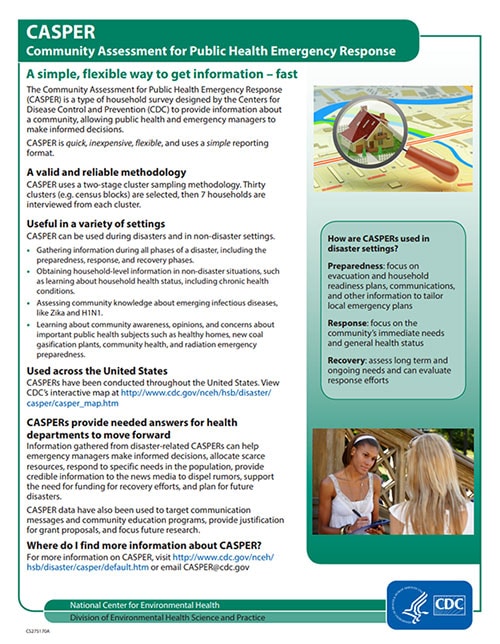Materials and Resources

NCEH has developed many guidelines, tools, materials, and resources to aid STLT health departments and other disasters in preparing for and responding to disasters and emergencies. For more information on these materials and resources, please contact Amy Helene Schnall at GHU5@cdc.gov
One Pagers & Factsheets
- CASPER overview
- CASPER: Flint Water Crisis
- CASPER: Deep Water Horizon (DWH) Oil Spill
- Sheltering During the COVID-19 Pandemic: Findings from Recent Online Surveys
- Sheltering During Hurricanes: Findings from a Recent Online Survey
- Evacuating During Hurricanes: Findings from an Online Survey (2023)
- Household Preparedness Fall 2020
- Household Preparedness Spring 2021
- Household Preparedness Fall 2021
Infographics
Forms & Templates
- Disaster Epidemiology Training Request Form [PDF – 457 KB]
- CASPER Interactive Map Form [PDF – 98 KB] (to include your CASPER on the map)
- CASPER Questionnaires and other field materials
- Disaster Mortality Surveillance form
- Disaster Morbidity Surveillance templates
Guidelines, Toolkits, & Primers
Guidance for Emergency Managers for Identifying At-Risk Groups
At-risk groups, also referred to as socially vulnerable populations, require special attention in a disaster. During disasters, populations with higher levels of social vulnerability are more likely to be adversely affected. This HS guidance document, titled Planning for an Emergency: Strategies for Identifying and Engaging At-Risk Groups [PDF – 12.2 MB], is designed specifically for emergency managers. The document describes a process that will help emergency managers identify at-risk groups in their communities. The information can help reduce vulnerabilities and enhance outcomes.
Community Assessment for Public Health Emergency Response (CASPER) Toolkit
CASPER Toolkit 3.1 [PDF 23.2 MB]: Please see the CDC CASPER webpage for more information.
A Primer for Understanding the Principles and Practices of Disaster Surveillance in the United States
CDC’s A Primer for Understanding the Principles and Practices of Disaster Surveillance in the United States [PDF – 9MB] was developed to provide introductory information on the purpose, importance, and methods for approaching disaster surveillance in the U.S. The audience for this primer is public health departments at state, local, tribal, and territorial levels. This document outlines how health departments can approach public health surveillance during a disaster and reviews principles and practices of disaster surveillance. It provides key concepts and challenges to consider when conducting disaster surveillance, but does not give step-by-step guidance. The principles and practices described in this document can be useful for developing surveillance systems for disasters if existing systems do not exist, or for leveraging or modifying existing systems for disaster situations.
Death Scene Investigation Toolkit
CDC’s Death Scene Investigation after Natural Disasters or other Weather -Related Events (Print only) [PDF – 1.44 MB] (Espanol/Spanish toolkit [PDF – 807 KB]) features checklists, forms, and other resources for death scene investigators to use when collecting data at death scenes during and after a natural disaster or weather-related event.
To use refillable forms specific to certain disasters, see these links:
- Heat [PDF – 664 KB]/ Español (Spanish) [PDF – 471 KB]
- Winter [PDF – 868 KB]/ Español (Spanish) [PDF – 1.14 MB]
- Tornado [PDF – 675 KB]/ Español (Spanish) [PDF – 841 KB]
- Hurricane [PDF – 864 KB]/ Español (Spanish) [PDF – 563 KB]
- Thunder/Lightening [PDF – 695 KB]/ Español (Spanish) [PDF – 936 KB]
- Earthquake [PDF – 621 KB]/ Español (Spanish) [PDF – 220 KB]
A literature review to examine how death scene data are collected and how such data are used to determine disaster relatedness informed the new toolkit. More information about the literature review can be found in the article, Medicolegal Death Scene Investigations After Natural Disaster- and Weather-Related Events: A Review of the Literature [PDF – 1.55 MB].
Reference Guide for Death Certification
Disaster-related mortality data collected from death certificates are used to assess the scope of a disaster, identify common risk factors for these deaths, and develop evidence-based public health interventions. The key to more accurate reporting of disaster-related deaths is to promote a common framework and decision-making process for determining disaster relatedness. CDC’s A Reference Guide for Certification of Deaths in the Event of a Natural, Human-induced, or Chemical/Radiological Disaster [PDF – 945 KB] provides examples and recommendations for recording the name and type of disaster on the death certificate to ensure that disaster relatedness is reflected appropriately on the death certificate.
- Community Assessment for Public Health Emergency Response (CASPER)
- CDC Emergency Preparedness and Response
- CDC Natural Disaster and Extreme Weather Events
- Radiation Emergencies
- Disaster Epidemiology: FAQs
- Public Health Assessment and Surveillance after a Disaster
- CSTE Disaster Epidemiology Subcommittee
- NIH Disaster Research Response (DR2)
- Recent Publications in Disaster Epidemiology
